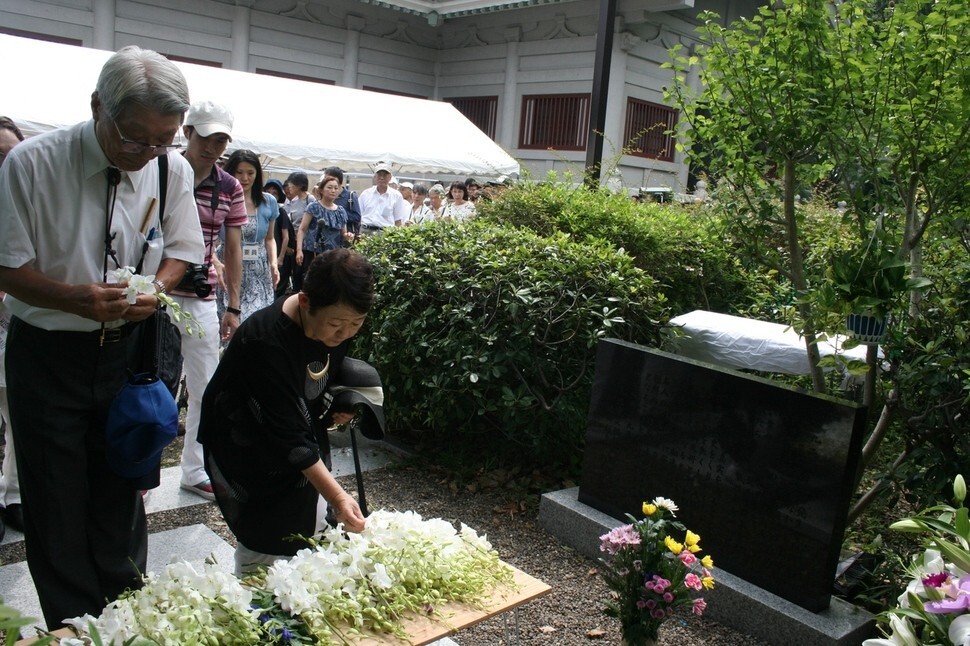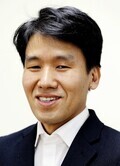hankyoreh
Links to other country sites 다른 나라 사이트 링크
[Correspondent’s column] A word of gratitude to the “quiet” Japanese activists

I recently returned to South Korea after spending three years and three months in Japan as a foreign correspondent. During that time, there were a few events I attended every year, one of which was the memorial service for Korean victims of the Great Kanto Earthquake of 1923, which is held on Sept. 1 at Yokoamicho Park in Tokyo’s Sumida Ward.
Following a huge earthquake that devastated the Kanto region of Japan, including Tokyo, on Sept. 1, 1923, rumors spread that Koreans were poisoning the wells, which led to the deaths of thousands of Koreans at the hands of the Japanese police and vigilante bands. Memorial services for the Koreans killed in these massacres are held on the anniversary of the massacre at various locations throughout the Kanto region. One of those services is the one at Yokoamicho Park, which dates back to 1974.
For nearly half a century, therefore, Japanese citizens have been holding the Yokoamicho Park memorial service. That’s no easy task, and it got even harder in 2017, the year after Yuriko Koike was elected governor of Tokyo. In 2017, Koike stopped sending messages of condolences to the Korean victims, halting a practice maintained by her predecessors in the post.
Koike’s excuse was that she wanted to “simultaneously mourn all of the victims” who died in the Kanto earthquake. Critics objected that there was a qualitative difference between dying in a natural disaster and being killed in a massacre, but Koike paid them no mind. Since 2017, a Japanese right-wing group has been holding an event designed to obstruct the memorial service at a site less than a hundred meters away.
These events symbolize the rightward shift in Japanese society, but there’s another lesser-known aspect of the story that I’d like to share. The number of people attending the memorial service for Korean victims has actually been increasing since 2017, when Koike stopped sending her condolences. In 2017, there were about 500 people present, 50% more than in 2016. By last year, the number had risen to 700. When the city of Tokyo recently threatened to withhold permission for the service unless the organizers pledged to abide by the law, more than 30,000 Japanese citizens signed a written complaint.
During my time in Japan, there were several occasions on which I saw Japanese citizens pushing back against the rightward shift in their society. One of those times was the summer of 2017, when a right-wing group organized a hate speech rally at the Peace Park in Kawasaki, a city in Kanagawa Prefecture, in the greater Tokyo area. Japanese citizens surrounded the entire park in a counter-protest. After only moving forward a few meters, the right-wing protesters had to retreat.
Last year, a statue of a young girl symbolizing the comfort women was displayed at the Aichi Triennale, an international art festival in Aichi Prefecture. The exhibition featuring the statue was closed just three days after opening because of intimidating phone calls from right wing activists. But thanks to protests from citizens and the efforts of the exhibition organizers, the exhibition was dramatically reopened for the festival’s final week.
Not as flashy as S. Korea, but consistent and patientCompared with South Korea, Japan’s civil-society movement is not as flashy. Rallies that bring out hundreds of thousands of people, as Korea’s candlelit rallies did, disappeared long ago. Demonstrations in Japan are fairly sedate, mostly consisting of speeches, and the slogans chanted by demonstrators lack the vehemence of Korean protests.
But I’m often surprised to see how patiently, and how persistently, Japanese activists maintain their efforts. In various parts of Japan, there are Japanese who have studied and protested for decades in connection with issues such as the compulsory mobilization of Koreans under the Japanese empire, the suffering of the comfort women, the massacre of Koreans after the Kanto earthquake, and the repatriation of the remains of Korean soldiers and civilian employees of the military.
At numerous points in the fact-finding reports that the South Korean government has composed about the victims of compulsory mobilization, it is obvious that assistance was provided by these “quiet” Japanese activists. On a personal level, I don’t think I could have effectively covered stories in Japan if not for those activists’ help. Once again, I’d like to express my gratitude to them.

By Cho Ki-weon, Tokyo correspondent
Please direct comments or questions to [english@hani.co.kr]

Editorial・opinion
![[Column] Life on our Trisolaris [Column] Life on our Trisolaris](https://flexible.img.hani.co.kr/flexible/normal/500/300/imgdb/original/2024/0505/4817148682278544.jpg) [Column] Life on our Trisolaris
[Column] Life on our Trisolaris![[Editorial] Penalties for airing allegations against Korea’s first lady endanger free press [Editorial] Penalties for airing allegations against Korea’s first lady endanger free press](https://flexible.img.hani.co.kr/flexible/normal/500/300/imgdb/original/2024/0502/1817146398095106.jpg) [Editorial] Penalties for airing allegations against Korea’s first lady endanger free press
[Editorial] Penalties for airing allegations against Korea’s first lady endanger free press- [Editorial] Yoon must halt procurement of SM-3 interceptor missiles
- [Guest essay] Maybe Korea’s rapid population decline is an opportunity, not a crisis
- [Column] Can Yoon steer diplomacy with Russia, China back on track?
- [Column] Season 2 of special prosecutor probe may be coming to Korea soon
- [Column] Park Geun-hye déjà vu in Yoon Suk-yeol
- [Editorial] New weight of N. Korea’s nuclear threats makes dialogue all the more urgent
- [Guest essay] The real reason Korea’s new right wants to dub Rhee a founding father
- [Column] ‘Choson’: Is it time we start referring to N. Korea in its own terms?
Most viewed articles
- 1New sex-ed guidelines forbid teaching about homosexuality
- 260% of young Koreans see no need to have kids after marriage
- 3[Column] Life on our Trisolaris
- 4OECD upgrades Korea’s growth forecast from 2.2% to 2.6%
- 5Presidential office warns of veto in response to opposition passing special counsel probe act
- 6Months and months of overdue wages are pushing migrant workers in Korea into debt
- 7[Guest essay] Maybe Korea’s rapid population decline is an opportunity, not a crisis
- 8Trump asks why US would defend Korea, hints at hiking Seoul’s defense cost burden
- 9[Editorial] Penalties for airing allegations against Korea’s first lady endanger free press
- 10Japan says it’s not pressuring Naver to sell Line, but Korean insiders say otherwise